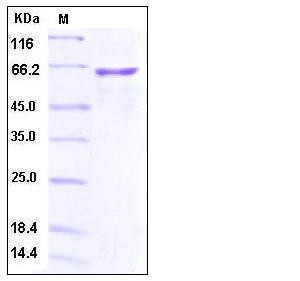Human Latexin / LXN / TCI Protein (Fc Tag)
ECI,TCI
- 100ug (NPP4048) Please inquiry
| Catalog Number | P10211-H01H |
|---|---|
| Organism Species | Human |
| Host | Human Cells |
| Synonyms | ECI,TCI |
| Molecular Weight | The recombinant human Fc/LXN is a disulfide-linked homodimeric protein.The reduced monomer consists of 458 amino acids and predicts a molecular mass of 52 kDa. As a result of glycosylation, the apparent molecular mass of rhFc/LXN monomer is approximately 60-65 kDa in SDS-PAGE under reducing conditions. |
| predicted N | Glu 20 |
| SDS-PAGE |  |
| Purity | > 90 % as determined by SDS-PAGE |
| Protein Construction | A DNA sequence encoding the human Latexin (NP_064554.3) (Glu 2-Glu 222) was fused with the Fc region of human IgG1 at the N-terminus. |
| Bio-activity | |
| Research Area | Immunology |Inflammation / Inflammatory Mediator |Cells Involved in Inflammation |Monocyte/Macrophage |
| Formulation | Lyophilized from sterile 100mM Glycine, 10mM NaCl, 50mM Tris, pH 7.5 1. Normally 5 % - 8 % trehalose, mannitol and 0.01% Tween80 are added as protectants before lyophilization. Specific concentrations are included in the hardcopy of COA. |
| Background | Mouse Latexin, also known as endogenous carboxypeptidase inhibitor, tissue carboxypeptidase inhibitor, TCI, ECI and LXN, is a cytoplasm protein which belongs to the protease inhibitor I47 (latexin) family. It is highly expressed in heart, prostate, ovary, kidney, pancreas, and colon. Latexin / LXN is the only known endogenous specific inhibitor of zinc-dependent metallocarboxypeptidases (MCPs) present in mammalians so far. Latexin is originally identified as a molecular marker for the regional specification of the neocortex in development in rats. The 222 amino acid latexin in human shows different expression distribution with high levels in heart, prostate, ovary, kidney, pancreas, and colon, but only moderate or low levels in other tissues including brain. Latexin is also expressed at high levels and is inducible in macrophages in concert with other protease inhibitors and potential protease targets, and thus is suggested to play a role in inflammation and innate immunity pathways. Despite of the non-detectable sequence similarity with plant and parasite inhibitors, Latexin is related to a human putative tumor suppressor protein, TIG1. In addition, Latexin is also implicated in Alzheimer's disease. |
| Reference |
